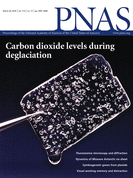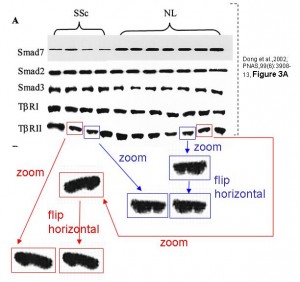 Authors have retracted a 2002 paper from PNAS because part of a figure “may have been fabricated,” and they no longer have the original data to prove otherwise.
Authors have retracted a 2002 paper from PNAS because part of a figure “may have been fabricated,” and they no longer have the original data to prove otherwise.
The paper in question, “Deficient Smad7 expression: A putative molecular defect in scleroderma,” studied the signaling pathways that may underlie the autoimmune disease. It has been cited 198 times, according to Thomson Reuters Web of Science.
The authors, led by Pascal J Goldschmidt-Clermont, currently the Dean of the School of Medicine at the University of Miami, have issued a retraction note, which appeared online yesterday:
The authors wish to note the following: “It has recently been brought to our attention that some of the elements in Fig. 3 of our paper may have been fabricated. Unfortunately, because of the time elapsed since publication, we no longer have in our possession the original gels and blots that were used to produce the figure. While we trust that the other data in the paper is genuine and the overall conclusions sound, we have no alternative but to request a retraction of our paper. We apologize for any inconvenience this may cause.”
An allegation about figure 3 appeared on PubPeer last November, noting:
Apparent duplication + rotation of bands in Fig. 3A.
In December, a comment signed by Goldschmidt-Clermont and Chunming Dong, also at Miami, noted that they were trying to figure out what happened:
The data for this paper was generated between 13 and 16 years ago, and we are trying to find the original data used to produce the figure in question, and also who amongst the authors was responsible for producing the data and the resulting figure.
The pair worked at the Duke University Medical Center at the time the paper was published.
Recently, we saw a paper retracted under similar circumstances — after PubPeer suggested potential image manipulation, the authors could not provide the original data because it had apparently been lost in a flood.
Here is the figure from the retracted paper, Figure 3A, which contains “Apparent duplication + rotation of bands,” according to a peer:
On PubPeer, there is a question about an image in another paper by Goldschmidt-Clermont and Dong, on which Shoukang Zhu, also now at the University of Miami, is also a co-author.
Like Retraction Watch? Consider making a tax-deductible contribution to support our growth. You can also follow us on Twitter, like us on Facebook, add us to your RSS reader, sign up on our homepage for an email every time there’s a new post, or subscribe to our new daily digest. Click here to review our Comments Policy. For a sneak peek at what we’re working on, click here.

This is a chilling retraction. What would one do if they received an email from a journal saying, “we have become aware of an anonymous post on PubPeer that questioned the accuracy of the data behind your figure 5 in your 14-year old publication. We have initiated an investigation and will need to inspect your original imagery, raw data, notebooks, and other materials at your dear alma matter that you haven’t set foot in since. If you are unable to provide the necessary records for our inspection, we may need to retract your article.”
How many of us could produce detailed supporting evidence from far away and long ago? How could one defend oneself against an unfounded or misinformed challenge?
I had a request last year for raw data behind my first (2001) publication, and after borrowing a zip drive reader and plowing through hundreds of obtuse old 8.3 character Windows filenames, I eventually had to respond with embarrassment that I couldn’t locate exactly what they were seeking. I’ve become more religious about data archiving, but shame on me, I haven’t always been very good about it, and after a few years and moves, the project boxes end up in the recycle bin. Guess I (and many others) are vulnerable to showing up in RetractionWatch if challenged to reproduce analyses from long ago.
Data handling is something that should be taught to all grad students and postdocs. Looking back on my grad school days, I can see that my datake handling was spotty for the first few years. I would often copy and paste or simply type my raw numbers into a spreadsheet for analysis and then forget about the actual raw files from the data collection software. Eventually, network drives get cleaned off and a lot of those original files are probably gone for good. If someone asked for the data from my earliest experiments now, I would only be able to furnish my Excel spreadsheets and a few hand written values and notes (I did keep all of my blots though). But I didn’t know any better back then. I reasoned that all data were recorded by hand in notebooks before the computer age, and typing the values into a spreadsheet or writing them in my notebook was basically the same thing. I was eventually scared into more meticulous data-keeping practices after sites like PubPeer began popping up. But the point is, grad schools don’t have any formal data management classes. Your busy PI is expected to handle those things, but s/he usually does not.
Pubpeer has comments about possible image irregularities in two additional publications where Goldschmidt-Clermont and Dong are authors. In both cases, the author/s (as identified by pubpeer) responded in May 2016 and noted that they have notified the Journals (Circulation, and Circulation Research) about these possible problems. Since then, there is no update about the status of these papers.
(1) https://pubpeer.com/publications/18981303
(2) https://pubpeer.com/publications/14739161
Two publications with authors including Goldschmidt-Clermont and Dong have PubPeer comments about possible image irregularities. In both cases, author/s replied in PubPeer and stated that they have reported the issue to the Journal editors, but received no reply. If this is true, the delay in the Journals response to the authors is truly remarkable:
(1) “Circulation”: Author/s state on May 23rd, 2016 that journal was notified, and on February 18th, 2017 author/s state “No response from the Journal after I have inquired twice. ”
8 months with no response!
https://pubpeer.com/publications/18981303
(2) “Circulation Research”: Author/s state on May 10th, 2016 that journal was notified, and on February 18th, 2017: “No response yet.”
8 months with no response!
https://pubpeer.com/publications/14739161